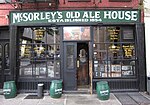Saint George Ukrainian Catholic Church
Byzantine Revival architecture in New York CityChurches completed in 1978Churches in ManhattanEast Village, ManhattanEastern Catholic churches in New York (state) ... and 2 more
Ukrainian-American culture in New York CityUkrainian Catholic churches in the United States

Saint George Ukrainian Catholic Church (Ukrainian: Українська Католицька Церква Св. Юра) is a Ukrainian Greek Catholic Church located in East Village, Manhattan, New York City, at 7th Street and Taras Shevchenko Place. The church and the adjoining St. George Academy are encircled by, but not included in, the East Village Historic District. For over 100 years, this Ukrainian parish has served as a spiritual, political and cultural epicenter for several waves of Ukrainian Americans in New York City.
Excerpt from the Wikipedia article Saint George Ukrainian Catholic Church (License: CC BY-SA 3.0, Authors, Images).Saint George Ukrainian Catholic Church
East 7th Street, New York Manhattan
Geographical coordinates (GPS) Address Phone number Website Nearby Places Show on map
Geographical coordinates (GPS)
| Latitude | Longitude |
|---|---|
| N 40.72843 ° | E -73.98976 ° |
Address
St. George's Church
East 7th Street 30
10003 New York, Manhattan
New York, United States
Open on Google Maps











